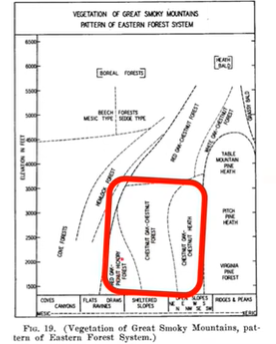Southern Appalachian Forests: Low Elevations
Southern Appalachian Forests: Low Elevations
Where is the largest remaining tract of old-growth cove hardwood forest?
Joyce Kilmer Memorial Forest, Morrisville, NC
The Big Questions
Why do the southern Appalachians have such high species diversity?
What factors explain the species composition and structure we see in southern Appalachian forests?
Do you think it is the ACTUAL ELEVATION that affects species distribution? Which 2 environmental factors would be correlated with elevation?
Geography, moisture, temperature, soil type, disturbance, or topographic position? Choose 2.
Temperature and moisture.
Lessons from Gregory Ridge Trail
Each species has a unique niche
Many niches = many species
Topographic position affects moisture
What explains high biodiversity in the southern Appalachians?
Climate (temperature and precipitation)
Geology
Disturbance (any event that moves some or all of the existing vegetation)
Biogeography (both boreal and tropical species)
Whittaker 1956 — Vegetation of the Great Smoky Mountains

Found that elevation (y axis) and topographic position (x axis) are related
Oak-Pine, Oak-Chestnut Forest
Low elevation forests (1500-4000 ft)
Cove forests
rich cove
avid cove
Montane Oak Forests
Pine-oak-heath
High elevation forests (4000-6684 ft)
high elevation red oak forest
northern hardwood forest
spruce-fir forest
Elevation, moisture, topography, and soils are major factors that separate these types
Cove forests
All coves have a concave, bowl-like shape, sheltered slopes (landform)
Low to mid-elevations (1500-4000 ft)
Not moisture limited
Very diverse (but species composition varies)
Also biologically diverse with many endemics
Rich coves have fertile soil
higher species diversity than acid coves
Acid coves have acidic soil
Rich cove forest (cove hardwoods)
low elevation
most mesic in topographic
complex structure and layering
protected, bowl-shaped topography
highest species diversity = high wildlife diversity
low disturbance—no fire, protected from wind and storms
lots of wildflowers!
Species found here:
Yellow-poplar found here (early successional species in the mountains, fast-growing but also long-lived)
shortleaf pine is early succession in rest of Piedmont
Sugar maple (northern species, source of maple sugar and maple syrup)
White ash
Black cherry
Basswood
Acid cove forest
Closed canopy and dominant shrub layer
Protected, bowl-shaped topography
Lower species diversity than rich coves; higher shrub component
Disturbance: prior logging, no fire, invasive insects
Species found here:
Eastern hemlock (stream-loving species, decimated by the hemlock woolly adelgid; most old-growth is gone, important streamside habitat species for shading and cooling the water)
Sweet birch
White pine
Rosebay
The primary environmental difference that results in a rich cove versus an acid cove is soil pH
Montane Oak Forest
moderate to low elevations
open slopes
some low intensity fire
somewhat open forest
can have rich understory depending on soil type
extensive logging history

Ellicott Rock Wilderness, intersection of NC/SC/GA
Species found here:
American chestnut (once made up 25% of the canopy trees in the Appalachians, now functionally extinct)
Rock chestnut oak (most common tree in the mountains, dry forests, middle elevations and below)
Scarlet oak (broadly Appalachian, xeric habitats, thin bark)
White oak (somewhat fire-tolerant, moist to dry forests, most abundant tree of eastern North America)
Northern red oak (mesic forests, low elevation)
Mockernut hickory
Pignut hickory
Red maple (ubiquitous and growing in abundance in the absence of fire)
Mountain laurel (wide-spread in eastern NA, xeric forests, heath balds)
You would expect to find Quercus montana and Quercus coccinea in drier, rockier sites
Pine-oak-heath woodland
Ridges and other dry, convex topography
often has thin soils
lower elevations have more structure and diversity
canopy is often a woodland than a closed forest
exposed to wind and sun
fire adapted; declining without fire as other species outcompete pine
The understory, which you can see is covered completely with a short shrub with small leaves. This is the Heath part of Pine-Oak-Heath - in this case that heath (in the Ericaceae family, remember) is either Vaccinium (blueberry) or Gaylussacia (huckleberry). Both are really important and widespread shrubs in the southern Appalachians.
Species found here:
Shortleaf pine
Virginiana pine
Pitch pine (fire-adapted with catastrophic fire with epicormic branching)
Table Mountain Pine (fire-adapted to catastrophic fires with serotinous cones)
Carolina hemlock (also killed by hemlock woolly adelgid)
Mountain laurel (wide-spread in eastern NA, xeric forests, heath balds)
Scarlet oak (broadly Appalachian, xeric habitats, thin bark)
At higher elevations on exposed ridgelines in the southern Appalachians, the canopy gets shorter
Pine-Oak-Heath: Convex ridgelines, exposed
Cove Forest: concave, protected sites
Montane Oak Forest: open slopes